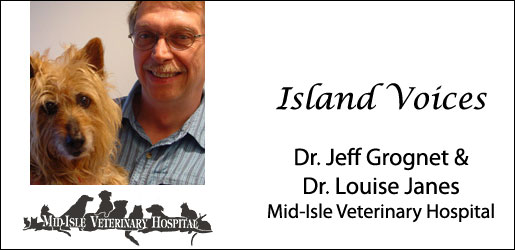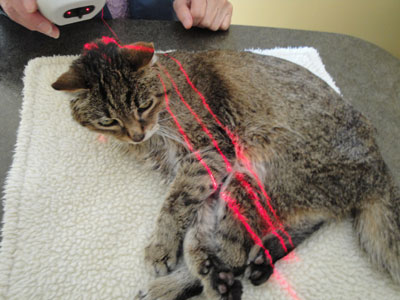Archive ∙ Back to Island Voices
December 2011
John Denver was right when he said “sunshine on my shoulders makes me happy”. One of the reasons you feel better on a bright, sunny day is because sunshine, a form of light therapy, makes you healthier. As of August 2010, we have been offering a remarkable therapy to our patients. It is an Erchonia laser.
Light therapy stimulates healing on many levels. It is especially effective for musculoskeletal and neurological disorders, but it can also be beneficial to patients with organ dysfunction such as chronic kidney deterioration or liver disease. Even more exciting is the fact that dogs and cats with allergies, immune disorders and even some forms of cancer can experience beneficial effects from light energy healing.
The majority of lasers utilized by veterinarians and chiropractors are powerful lasers. They rely on strength and penetration to warm tissue and effect healing. These are useful for arthritis and inflammatory conditions because they run at 10,000 to 50,000 milliwatts (mW). The people and the patient must wear eye protection (as little as 1/10 second exposure can induce retinal damage).
Our laser, classified as low level laser therapy (LLLT), operates at 5 mW. It is safe (no goggles required) and does not “cook” tissue. It does, however, effectively trigger the body’s innate ability to heal itself by its frequency (the number of times it blinks each second).
It directs normal cellular function, repair, and reproduction through photon (light particle) communication. Because the body is made up of 70 percent water, it is easy for energetic messages to travel from cell to cell and tissue to tissue.
Cells become diseased when they lose their ability to communicate with each other. They stop functioning properly because they are not being directed or, worse yet, they start to function in an unwanted manner (the ultimate example of this is cancer cells that grow without response to physiological control mechanisms).
Re-establishing communication between cells can bring tissues back to health. This is the premise behind frequency-specific LLLT. By directing specific frequencies of light to diseased tissues, we can prompt communication. In fact, every tissue has a frequency that it responds to.
The light hits the skin and spreads like a wave through the body. Once it reaches the target tissue, it nudges the cells back toward normal function. The body is able to do what it does best, heal itself.
Though this is an energetic explanation, there is also a scientific basis to this technology. Frequency-specific LLLT has an impact on mitochondrial DNA. When damaged by disease or toxins, DNA becomes unravelled. The light emitted from our laser stimulates the generation of ATP which rehabilitates the DNA back to a functional 3-D shape.
Most patients need, on average, 13 light therapy sessions, but this will be determined by the severity and chronicity of the disease processes. Treatment is not stopped as soon as the symptoms resolve; it is continued until maximal healing has occurred.
The positive effects of each session are cumulative so the frequency of treatment is determined by how quickly we want or need healing – is the body in an emergency state, or are we dealing with chronic disease? If we need to get rapid resolution of an illness, we treat twice daily for three days, then once daily for three days, then twice weekly for 2-3 weeks.
In many cases, we follow a less intensive program that begins with two treatments the first day followed by another one within the week. Then we treat twice weekly for 2 weeks, once weekly for 4 weeks, and possibly twice a month for 3 months.
No matter what schedule is chosen, it is important that the first two treatments be no more than 24 and no less than 1-1/2 hours apart. These initial light therapy sessions stimulate 70 percent of healing. The beneficial effect of these two light therapy sessions may show up within hours or it may not appear until the middle of the second week.
Reference: www.vomtech.com/vetcoldlaser.html
For more information contact Dr. Jeff Grognet or Dr. Louise Janes at
Mid-Isle Veterinary Hospital
5-161 Fern Road West
Qualicum Beach, BC
Tel (250) 752-8969



Leave a Reply